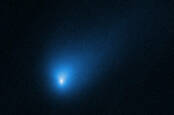This article is more than 1 year old
Boffins examine interstellar comet Borisov to find out what its home was like. Pretty unpleasant, it seems
No wonder it came all the way over to our Solar System
Astronomers have for the first time measured the chemical composition of an interstellar comet: 2I/Borisov, which strayed into our Solar System last year.
Two separate studies published in Nature Astronomy on Monday revealed the speeding icy ball of gas and dust contained a surprising amount of unpleasant carbon monoxide. Observations showed Borisov contained more than three times the CO gas previously measured for any comet within our own inner Solar System.
“The high amount of carbon monoxide is an indication that it comes from a very cold place, either extremely far away from its host star or from a relatively cold star,” said Jian-Yang Li, co-author of one of the papers and a senior scientist at the Planetary Science Institute in Arizona, USA.
“We think it’s more likely to be the latter case – it comes from a cold red dwarf because there are far more red dwarfs in our Milky Way galaxy than other hotter stars. However, we are still far from saying exactly what’s going on around its host star when planets formed there."
The boffins detected whiffs of carbon monoxide, water vapor, and hydrogen cyanide as the comet passed our Sun. The solar radiation vaporized the outer skin the comet, releasing its contents in a glittering stream of gas and dust that could be detected using the Hubble Space Telescope.
The astronomers behind the first paper, led by Dennis Bodewits of Auburn University, Alabama, are confident the observed carbon monoxide is directly from the comet’s nucleus. Carbon monoxide ice is volatile. It begins to vaporize at a distance of 11 billion miles away from our Sun. Water ice, on the other hand, stays intact until about 200 million miles away.
"The amount of carbon monoxide did not drop as expected as the comet receded from the Sun,” said Bodewits. “This means that we are seeing the primitive layers of the comet, which really reflect what this object is made of."
Li explained to The Register the link between carbon monoxide and cold temperatures lies in the gas’s freezing point: “We can infer cold temperature from carbon monoxide because carbon monoxide ice has an extremely low freezing temperature, minus 400 deg Fahrenheit (minus 240 degrees Celsius), compared to that of water at 32 degrees Fahrenheit (0 degrees Celsius), or that of carbon dioxide at about -110 degrees Fahrenheit (-79 degrees Celsius).

Hubble grabs first snap of interstellar comet... or at least that's what we hope this smudge is
READ MORE“If we see lots of carbon monoxide preserved in the comet, that means the comet must have both formed under extremely low temperature where lots of carbon monoxide ice could exist, and never heated significantly above that low temperature ever since, because otherwise carbon monoxide would have vaporized and [it would be] lost in space.”
So long, Borisov
Comets are chunks of left-over stuff that formed around protoplanetary disks circling newborn stars. Studying ones like Borisov, which came from far beyond our Solar System, therefore gives us an idea of the environment inside alien planetary systems.
“We generally consider comets as the ‘original building blocks’ of gas giants and their major satellites in our Solar System. So this comet should represent the building blocks of exoplanets around their parent star,” said Li.
The team behind the second paper believes the alien visitor may be a fragment from a dwarf planet that broke off and escaped. “If that object collided with another, then the carbon monoxide-rich fragments could be released into space,” said Martin Cordiner, lead author of that paper and an astrochemistry expert at NASA’s Goddard Space Flight Center.
It’s also possible Borisov is really a comet and wandered into our Solar System after it was ejected from its home due to the gravitational instability of a larger exoplanet.
“If a Jupiter-sized planet migrates inward, it could kick out a lot of these comets,” Bodewits said.
“Then, after a cold, lonely voyage, 2I/Borisov made its close encounter with our solar system and started outgassing and showing us what it’s got inside,” Cordiner added.
“Our solar system is so tiny compared to the distances between star systems. For an interstellar comet to come in and hit the bullseye like Borisov did is incredible,” he continued.
But their luck has now run out; it’s unlikely scientists will be able to study Borisov in more detail. “Unfortunately this comet is now moving away from us very quickly, and is quite faint now,” Li told El Reg. “It will eventually exit our solar system and never come back, so we won’t have another chance to observe this comet again.
“For this comet, researchers will put together all the pieces of information collected during its short visit in order to better understand the message this comet brought to us about its birth and its long journey. In addition, we are waiting for the next such comet coming to us to tell us more secrets about other extrasolar planetary systems.”
The comet was discovered by Gennady Borisov, an amateur astronomer and telescope maker in Crimea, in August last year. Although the object is the Solar System's first interstellar comet, it's not the first interstellar visitor scientists have spotted, however. That achievement goes to 'Oumuamua, the cigar-shaped asteroid seen in 2017. ®
